CURRENT CONDITIONS
-
Today's Outlook
-
Visibility
-
Snow (cm)24h3day7day
-
Conditions
-
Base (cm)BottomTop
-
Lifts open
-
Runs (%)
-
Temperature (°C)CurrentFeels Like
-
Road
-
Wind (km/h)
-
Barometric Pressure
人気の記事
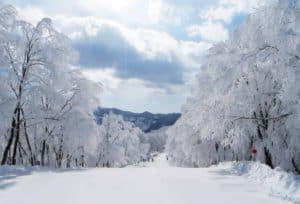
白馬バレー券を買うべき?
The Hakuba Valley Lift Pass gives holders access to 10 Mountains, 200+ runs, and [...]

evo Hotel Hakuba - Opening December 2024
evo Hotel Hakuba We are proud to introduce the newest entrant to the Hakuba hosp [...]
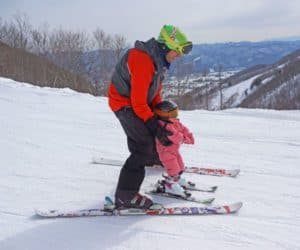
10 Tips For Stress Free Skiing With Kids
For the most part family ski holidays are tremendous fun and an opportunity for [...]

Hakuba's Luxury Dining
Who says a ski holiday can’t come with a world-class culinary experience? Haku [...]
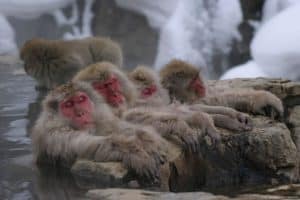
The Ultimate Guide to Japanese Snow Monkeys
Nestled in the heart of the Japanese Alps, the Hakuba Valley is among the best p [...]
10 Tips For Stress Free Skiing With Kids
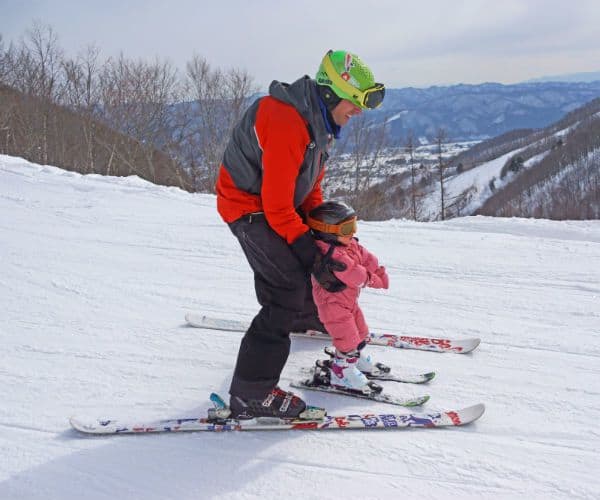
For the most part family ski holidays are tremendous fun and an opportunity for lifelong memories. However, there is always a chance for a meltdown or two that can leave the kids crying in the snow and the parents wondering why they bothered. Fortunately, we can minimize the chance of mishaps by taking a few simple precautions. Here are our tips for having the best day possible on the slopes with your kids.
Dress Them Right
Naturally we are happier when we are comfortable. A good thermal base top and bottom are essential, and materials such as merino wool or synthetics provide optimum warmth while remaining breathable. Follow that with a lightweight mid layer jacket made of down or synthetics and finish it off with a fully waterproof jacket and pants. You can`t go wrong with Goretex, and while a full piece suit is great for infants, they can become awkward as they get older – especially when going to the washroom.
Mittens are always the better option for kids as they are warmer than gloves and much less finicky when it comes to taking on and off. A good fitting helmet and goggles are key; so do spend some time making sure the goggles fit the face well, especially over the nose. Lastly, a neck warmer will keep them toasty on the lifts and during colder snaps, as well as prevent any rubbing on the chin from a helmet strap or jacket zipper.
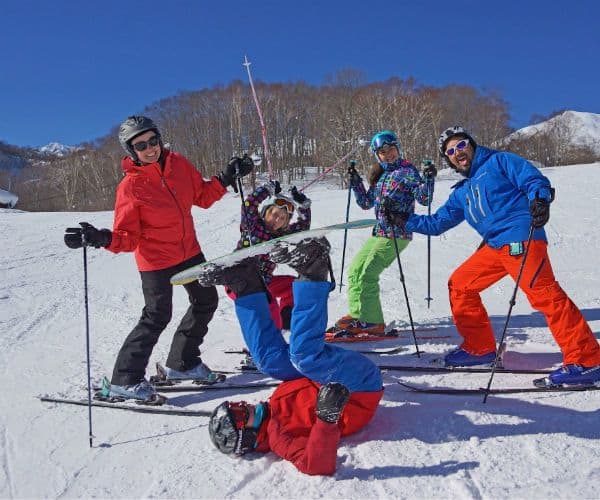
Avoid boot discomfort
While a great boot fitter and reputable rental shop will steer us in the right direction when it comes to renting or purchasing boots, we still need to make sure they are worn correctly. Start by pulling just 1 pair of quality ski socks up the leg as high as they go; this should be at least a few centimeters higher than the boot cuff. Wearing more than one pair is ineffective and increases the likelihood of blisters, as the two materials rub together and create wrinkles and pressure spots. For the same reason, make sure that nothing else is inside the boot apart from the sock – this includes thermals, leggings or pants. The tongue of the boot should be the first and only layer against your foot and shin, serving as a barrier between your socks and the outer plastic shell. You needn’t fully tighten them as soon as you put them on, but gradually do so as their legs and the boots warm up; they should not be so tight that they cannot be closed with one hand.
Do they really need poles?
Aside from being an extra piece of equipment for them to drop or loose, and something you`ll most likely end up lugging around for them, poles are not always necessary. In fact, first timers skiers and children under 7 don’t need ski poles. Used for rhythm, timing, body position, moguls and powder, they are often misused by smaller children and beginners as a crutch or balancing tool. This can be dangerous and encourages bad habits as the children tend to rely less on their lower bodies to ski.
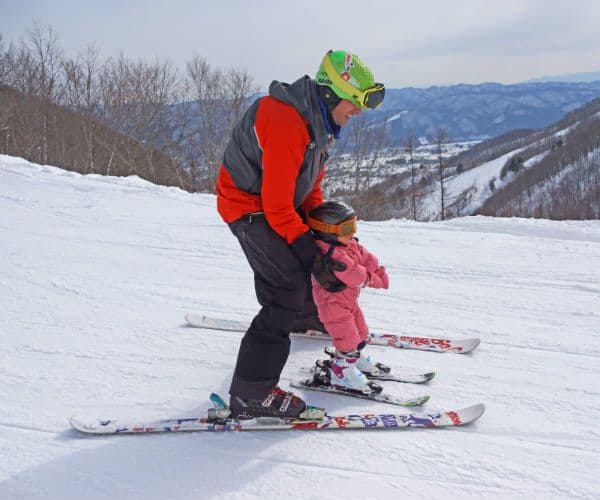
Poles can be introduced once the child is comfortable making basic turns, can remove them from their wrists when getting on and off chairlifts and doesn’t drag them behind or plant them in front between their skis whilst moving.
Be ticket smart
Put their lift pass in a zippered pocket that is on the same side as the scanner, at roughly the same level, and don’t put anything else in the pocket with the pass. Electronics and keys can confuse the scanners, but more importantly for the kids is that they wont have a reason to open or close that particular pocket, thus reducing the chance of loosing it in the process of reaching for something else – like a snack. All too often kids passes are kept with other things that they want to use during the day, and at some point the pass slips out in the midst of all the opening and closing. Place it in the pocket, zip it closed and tell your little one not to touch throughout the day.
Make good terrain choices
Few things are more stressful than dragging your kids to the top of the mountain only to realize that it is way too steep for them. Even for experienced skiers, always start out easy and work up to more challenging slopes. This means having thorough knowledge of their ability levels as well as the mountain and it`s terrain. If in doubt, invest time in studying the piste map or asking passers by; as an adult with kids in tow you should know where you are at all times. There is always time to build up to more challenging slopes, but it much harder to rebuild shattered confidence.
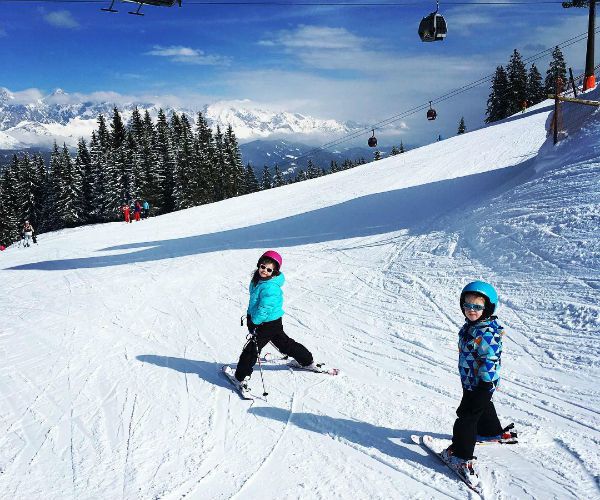
Establish chairlift rules
Though the chairlift seems like the ideal place to break open a snack, fidget with a device or bang our skis together, it isn’t. Particularly for kids it is all too easy to drop a pole or glove, knock a ski off, or loose something from pockets while reaching for something else. Having a general rule to keep your gloves or mittens on, not to bang your skis and only snack on what mum or dad has passed to you, will give you the best chance of avoiding items dropped in inconvenient places.

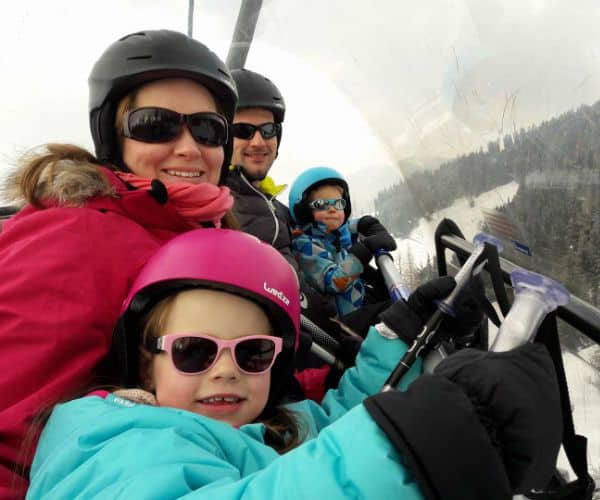
Listen for announcements
Mountain weather is notoriously temperamental and sudden changes can force lifts to suspend operation. Announcements will be given, though not always easy to hear and often in Japanese. Therefore pay particular attention when the wind picks up or snowstorms appear. These closures can be particularly problematic if you’re relying on downloading gondolas – these are often the first to close in strong winds – or if you need to return to a specific area to reach your car or shuttle bus. One mountain can have many different base areas some miles apart, so make sure you know how and when to make your way back. Ending up on the wrong side with small kids is not fun for anyone..
Make it fun!
Perhaps this should have been the very first point, but needless to say that we choose to do this because we want to have fun! This is so important for kids as a great experience will make them snow sport lovers for life, but a bad one can make for many difficult future ski holidays – especially for them. So how do we make it fun? We lead by example, showing our own enjoyment and by keeping a positive attitude. We play games with them on the snow – such as follow the leader – and allow them to repeat the slopes that they enjoy. Kids tend to gravitate towards passage through the trees and little jumps – so as long as it is safe, let them. Better yet, join them.
Allowing them to get maximum enjoyment can also mean having the patience of a saint while they have their tenth pee break, power plough at a snail’s pace or need to be scooped up every 3 meters. Pushing them too much too soon will make them tired, uncomfortable and unhappy; they have little legs and little muscles after all! Invest the time in them now and reap the rewards for years to come.
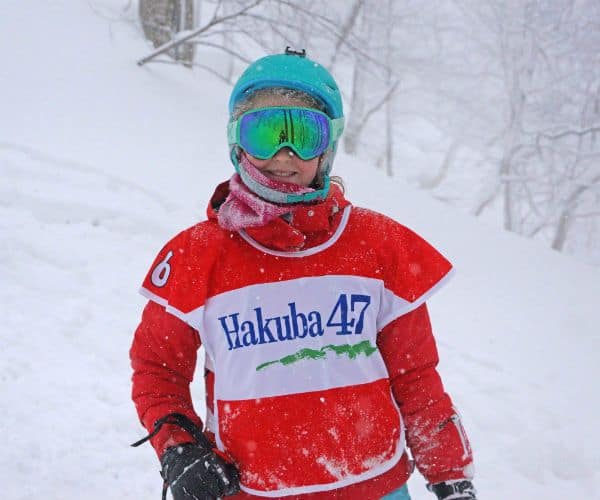

Know when to call it a day
By the same token, when kids fall down much more than they did earlier on similar slopes and take every opportunity to sit down in the snow, they’ve probably had enough. They may not know this themselves, but once they start to loose some muscle control it is a clear indication that they are tiring. The vast majority of accidents happen on the last run of the day when the conditions are the worst and everyone is the most tired. Call time before they hit the wall and start fresh the next day.
Plan your return
Seemingly obvious, but can slip through the cracks in our pre-planning, is transportation from the slopes. Make sure you know ahead of time how you plan to return to your accommodation; if you’re taking a bus know the times and locations, and if you’re shuttling with your accommodation know the details of that. No one wants to be lugging skis and kids around the town’s bus stops, fighting against the dark and cold. The day is a success when you’re back in the warmth of your accommodation – so plan your return.
Author
Nadine Robb is Owner and Instructor at 白馬スキー コンシェルジュ. Hakuba Ski Concierge is a boutique ski school in Hakuba, Japan.
A version of this blog first appeared on A Luxury Travel Blog
更に何かをお探しですか?